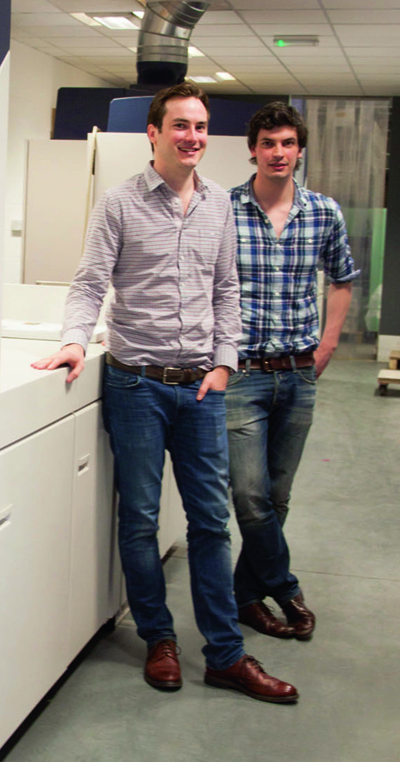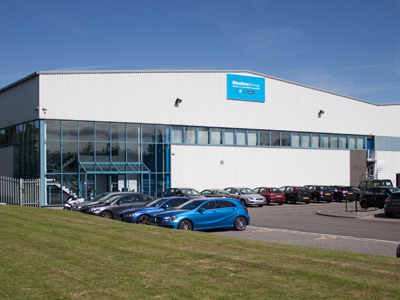It invests significant sums into IT, online systems and workflow automation, but trade printer RouteOne Print never forgets that it is old fashioned customer service that often wins the day.
The spirit of partnership is rapidly turning RouteOne Print into one of the UK’s premier trade printing services, evidenced by the new 100,000 square foot facility in Rotherham that it moved into in July. An ongoing approach to investment has most recently seen a B1 eight-colour Heidelberg press installed in the factory, as well as two of the latest HP Scitex 11000s and a couple of Xerox iGens (with room for another three).
Using the word rapid to describe the current rate of development in the business is no accident. How else can you put it when a company says that it is growing by about 37% per quarter, and is handling around 3500 jobs per day? It is this very growth that drove RouteOne to relocate to its new site, which is almost three times bigger than the previous sites combined.
The company’s story has been told in Digital Printer magazine before (see Digital Printer, May 2015), but loses nothing in the retelling. It began when two university friends – James Kinsella and Adam Carnell – started an online print shop called InstantPrint in 2009, having bought print to advertise club nights while studying, and thereby having formed an opinion that buying print should be a lot easier.
InstantPrint merged with the POS printer Bluetree in 2012 and RouteOne Print completed the Bluetree Group when it was established in 2013 as a trade print service operating online. They had noticed that trade customers were buying print on ebay, and formed another opinion: that if that was happening, there must be something missing in the online trade market. The two friends are both still in their mid to late 20s and preside over a business that has sales of £2 million per month and employs 180 people.
It has a strong in-house team of a dozen developers that are constantly improving its e-commerce presence, as well as programming a unique internal MIS system called iPop, that is able to integrate with third party systems such as production workflows. It has always sought to be more than just a good website though, and the ethos is just as important now as it was in the early days.
‘Version one of our site was at its heart a very basic ecommerce platform,’ said James Kinsella, ‘but we still found success because it was the relationship behind it that was central to the whole brand: that people felt they knew who they were buying print from, and that we were more than happy to take a phone call from them, discuss things, and offer up solutions.’
He went on: ‘The biggest difference between RouteOne and our competitors is that we want to be a print partner and work with resellers, rather than just selling any product. First and foremost you need a printer that will offer you print at a price that allows you to put a margin on it. Second, you need the service to be reliable. Price and reliability are becoming more of a given in the market; it’s not really a selling point so it came down to how we augment that and build up the experience for the buyer.
‘That gave us the idea of actually supporting people and we did not feel that our competitors were necessarily doing that; they were just offering a decent product at a good price. It is in our interests that clients do well, so what can we do to support them?’
One way that approach has manifested itself is in the provision of reseller tools that can help them to market themselves. Another way has been white label sample packs of different substrates. RouteOne discovered that customers were buying samples with their own branding on for promotional purposes and it now puts such transactions on a discounted rate. This makes perfect sense since RouteOne does well when its customers do well.
Many of these ideas have simply come from having a ‘feedback loop’ of constant open dialogue with customers. ‘At the heart of our brand is how personal it is for an online company,’ said Jack Wilmott, brand manager for RouteOne Print. ‘We have six account executives serving these clients, getting to know them, their requirements and how they operate. Having that much human interaction has broken down barriers, so customers give us feedback. It means that we are not going down blind alleys and we can instead work on projects that we know will offer value to the customer.’
The account managers are recruited mostly according to their attitude and personality, rather than needing a print background. It may not have been the objective, but a walk around the offices shows that this practice is certainly bringing new young people into the printing industry. ‘Really, what we are looking for is that they create and maintain that relationship with customers,’ Mr Wilmott continued. ‘We like them to have some personality about them. We want them to be able to think and react on their feet. They are empowered to make their own decisions and that’s the key thing. The customer service team spends time regularly in production with the printing, finishing and packing teams, and we are more than confident that we can train someone on the technical side of print. You cannot teach them decision making though.’

Adam Carnell and James Kinsella started the business in 2009
RouteOne does ‘obsess over the little details’ when it comes to customer service, he said, with two main KPIs in particular. The first is that account managers are expected to respond to emails within the hour. The second is that phones are answered within 10 seconds.
‘We monitor everything: how long it took to answer phones and how many people are getting through. With phone calls, the person who answers has to be able to deal with the query rather than having to refer it. We believe that a team has to be empowered to deal with the question rather than transfer it to other people.’
The investment in technology is as thorough as the investment in people. Mr Kinsella articulates the company’s ‘strict production philosophy’ in simple terms: ‘We say we have to run the latest kit for each process, and that always stacks up commercially.’ An example of this, and there are several, is with the new HP Scitex 11000 systems, which replaced two older HP Scitex 7600s. RouteOne is seeing big growth in work such as roller banners and exhibition pop-ups, and according to Mr Kinsella the HP Scitex 11000s are ‘twice as productive as the machines they replaced and the quality is like chalk and cheese’.
Bringing a new B1 litho press and a Muller Martini Presto A90 saddle stitcher into the factory has enabled it to competitively quote on jobs of more than 100,000 booklets, whereas before it was limited to runs of around 10,000. There is capacity for more sales growth with the existing equipment, and space in the new site to add even more when ready. As mentioned earlier, the group also has its own team of 12 software developers, which is kept busy improving the web platform and developing the bespoke barcode-driven iPop MIS that knits everything together, integrating websites, invoices and job statuses. It gives the company agility, flexibility and most of all control.
‘That’s something quite unique about us, that team of in-house developers that see the work going through the factory and live and breathe the brand rather than being at an agency. We have serious development capabilities in-house, and we do see ourselves as a technically-driven company,’ said Mr Kinsella.

The new Rotherham facility is almost three times bigger than the previous sites combined
Over the next three to six months there will be a series of functionality upgrades on the website, following a process of compiling customer requests and defining a list of functions that most customers want. These include improvements to customers’ ability to manage their orders, change details such as addresses, and track and trace jobs and invoices. Even bespoke orders can be placed, managed and tracked online, all the way through to proof of delivery.
‘That’s the most exciting part,’ said Mr Wilmott. ‘We are an online company; we are very automated and that’s how we keep transactional costs down, but within that we’ve always wanted to be very smart about how automated we are. We never want to have that rigid “computer says no” mentality. We are as flexible as we possibly can be at the moment, but we handle a lot of bespoke orders. We’re branching more into pack and collate campaigns. We’ve been asked for that by customers for quite a while but we could not deliver that at the old place; there wasn’t room to sort and separate.
‘People are becoming increasingly comfortable with buying print online. Print as a product is far more complex than anything you might buy from Amazon but we’ve found the balance of having those account managers that customers can talk to so close to the online offering.’
RouteOne is always looking for opportunities to increase its product range and will continue to do so, based on being confident that new additions are meeting customer demands and expectations. It is that ethos of partnership with customers shining through once again.





